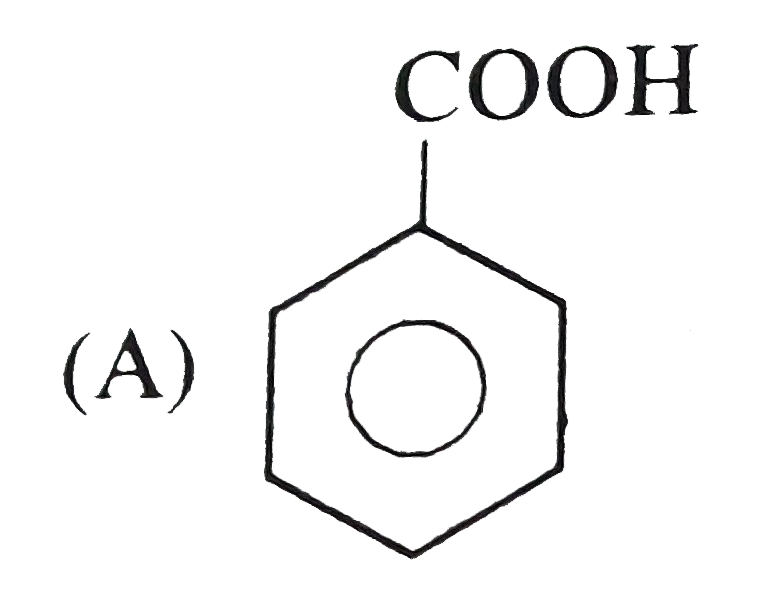Which has highest pKa value




The correct Answer is:A
To determine which acid has the highest pKa value among the given options, we need to understand the relationship between pKa and the strength of acids. The pKa value is inversely proportional to the strength of the acid; a higher pKa indicates a weaker acid.
1. Understand the Concept of pKa:
- pKa is defined as the negative logarithm of the acid dissociation constant (Ka).
- The formula is:
pKa=−log(Ka)
- A higher pKa value means a weaker acid, while a lower pKa value indicates a stronger acid.
2. Identify the Acids:
- Assume we have four acids to compare:
1. Benzoic acid
2. Nitrobenzoic acid (ortho)
3. Nitrobenzoic acid (meta)
4. Nitrobenzoic acid (para)
3. Analyze the Effects of Substituents:
- The presence of electron-withdrawing groups (like nitro groups) increases the acidity of the acids.
- The ortho effect can significantly enhance acidity due to steric and electronic factors.
4. Rank the Acids Based on Acidity:
- Ortho-nitrobenzoic acid: Strongest acid due to the ortho effect, which stabilizes the conjugate base.
- Para-nitrobenzoic acid: Weaker than ortho but stronger than meta due to the resonance effect.
- Meta-nitrobenzoic acid: Weaker than para because it does not have the same resonance stabilization.
- Benzoic acid: The weakest among the four as it lacks any strong electron-withdrawing groups.
5. Determine the pKa Values:
- The order of acidity (from strongest to weakest) is:
- Ortho-nitrobenzoic acid > Para-nitrobenzoic acid > Meta-nitrobenzoic acid > Benzoic acid.
- Therefore, the corresponding pKa values will be:
- Ortho-nitrobenzoic acid (lowest pKa) < Para-nitrobenzoic acid < Meta-nitrobenzoic acid < Benzoic acid (highest pKa).
6. Conclusion:
- The acid with the highest pKa value is benzoic acid.
Final Answer:
Benzoic acid has the highest pKa value among the given acids.
- pKa is defined as the negative logarithm of the acid dissociation constant (Ka).
- The formula is:
pKa=−log(Ka)
- A higher pKa value means a weaker acid, while a lower pKa value indicates a stronger acid.
- Assume we have four acids to compare:
1. Benzoic acid
2. Nitrobenzoic acid (ortho)
3. Nitrobenzoic acid (meta)
4. Nitrobenzoic acid (para)
- The presence of electron-withdrawing groups (like nitro groups) increases the acidity of the acids.
- The ortho effect can significantly enhance acidity due to steric and electronic factors.
- Ortho-nitrobenzoic acid: Strongest acid due to the ortho effect, which stabilizes the conjugate base.
- Para-nitrobenzoic acid: Weaker than ortho but stronger than meta due to the resonance effect.
- Meta-nitrobenzoic acid: Weaker than para because it does not have the same resonance stabilization.
- Benzoic acid: The weakest among the four as it lacks any strong electron-withdrawing groups.
- The order of acidity (from strongest to weakest) is:
- Ortho-nitrobenzoic acid > Para-nitrobenzoic acid > Meta-nitrobenzoic acid > Benzoic acid.
- Therefore, the corresponding pKa values will be:
- Ortho-nitrobenzoic acid (lowest pKa) < Para-nitrobenzoic acid < Meta-nitrobenzoic acid < Benzoic acid (highest pKa).
- The acid with the highest pKa value is benzoic acid.
Benzoic acid has the highest pKa value among the given acids.
Topper's Solved these Questions
- BOOK - ERRORLESSCHAPTER - CARBOXYLIC ACIDSEXERCISE - NCERT BASED QUESTIONS (Different Carboxylic Acids)15videos
CARBOXYLIC ACIDS
- BOOK - ERRORLESSCHAPTER - CARBOXYLIC ACIDSEXERCISE - PAST YEARS QUESTIONS30videos
CARBOXYLIC ACIDS
- BOOK - ERRORLESSCHAPTER - CARBOXYLIC ACIDSEXERCISE - NCERT BASED QUESTIONS (Substituted Carboxylic Acids)17videos
CARBOXYLIC ACIDS
- BOOK - ERRORLESSCHAPTER - BIOMOLECULES EXERCISE - ASSERTION & REASON16videos
BIOMOLECULES
- BOOK - ERRORLESSCHAPTER - CHEMICAL KINETICSEXERCISE - Assertion & Reason6videos
CHEMICAL KINETICS
Similar Questions
Knowledge Check
- Question 1 - Select One
Which has highest pKb value?
AR3C−NH2BR2NHCRNH2DNH3 - Question 2 - Select One
which has the highest pKa value ?
A B
B C
C D
D
- Question 3 - Select One
Which has the highest pKb value?
AR3C−NH2BR2NHCRNH2DNH3
Among the following acids which has the lowest pKa value ?
View SolutionAmong the following acids which has the lowest pKa value-
View SolutionAmong the following acid which has the lowest pKa value ?
View SolutionAmong the following acids, which has the lowest pKa value?
View SolutionWhich of the following has highest Ka value?
View Solution

